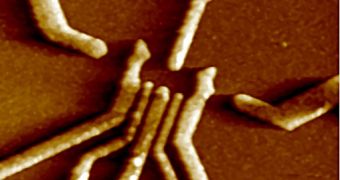Thousands of atoms form pairs and start shaking theirs booties on a mid-air dance floor, in fact a lattice of light formed by six laser beams. Their ability to move with the beat is not only a beautiful experiment, but it could be a breakthrough that could bring the quantum computers closer to reality.
The quantum computer is every IT specialist's hope and every average man's dream. It is essentially a computer that makes direct use of distinctively quantum mechanical phenomena for computation, like superposition and entanglement, to perform operations on data.
The basic principle of quantum computation is that the quantum properties of particles can be used to represent and structure data and that quantum mechanisms can be devised and built to perform operations with these data.
Researchers from the U.S. Commerce Department's National Institute of Standards and Technology published a paper that describes this atomic dance and the fact that each atom moves in perfect counterpoint to its partner could mean the ones and zeros of the computer language.
"You can do the equivalent of multiple classical calculations at the same time in the quantum world," said NIST's Trey Porto. Together with his colleagues, he coaxed pairs of super-cold rubidium atoms to repeatedly swap positions, a feat that could make them useful for storing and processing data in quantum computers.
Quantum bits can indeed oscillate between the one and zero positions, but "in the quantum world, instead of just the possibilities of zeros and ones, you have a range of possibilities," Porto said in a telephone interview to Reuters.
He also said that the pairs of atoms were isolated in a lattice of light formed by six laser beams all fixed on one point, so that they form an uniform pattern. "There is no container. It is levitated by the laser beams."
The scientists also devised a way to make these atoms take the form of a bit by forcing them to pass in and out of a state of entanglement, the two values required to form a bit. Porto describes it in terms of two magic coins spinning in the air. "While they are spinning, these coins are correlated so that if one is heads up, the other is always heads down," he said.
The only problem that stands in front of practical applications is the fact that they don't know how to get different pairs to dance and spin independent of the neighboring atom pairs, but they hope further studies will find the answer, thus bringing the quantum computer a bit closer.

 14 DAY TRIAL //
14 DAY TRIAL //